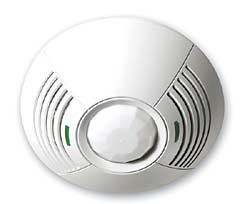Daylighting in Schools, Grades K-12
Photoelectric Light Sensors
A key element of all types of photoelectric control is the sensor, which detects the presence or absence of daylight and sends a signal to a controller that will adjust the lighting accordingly. Threshold on and off values can be set to respond to specific lighting conditions. These sensors can operate on/off switching of various luminaires or lamps within luminaires and they can also operate a continuous dimming system. Continuous dimming system may cost more than switching systems but they have greater user satisfaction because the change in lighting levels is not as noticeable. Added labor costs for additional wiring and circuits necessary for switching may increase the initial cost of a switching system.
|
||||||||||||||
The location of the sensor is important because it influences the type of control algorithm used. The photoelectric cell or sensor is often located on the ceiling and is calibrated on site to maintain a constant illuminance level. A single sensor that dims large areas can cause problems if buildings or trees overshadow some parts of the interior space. It has been found that with innovative daylighting systems such as light shelves, a partially shielded sensor (shielded from the window only) is not susceptible to sky conditions and direct light from the window. A controller is located at the beginning of a circuit (normally the distribution board or the ceiling space) and incorporates an algorithm to process the signal from the photosensor and convert it into a command signal that is received by the dimming or switching unit. Photosensor-activated dimmers may be the most important dimming technique. It matches the available natural daylight and lighting system output to produce consistent illuminance. Electronic or other dimming ballasts allow for control of the light level. These systems require careful integration of control systems and sensors.
|
||||||||||||||
Occupancy Sensors
Occupancy sensors detect when a space is occupied by using passive infrared, ultrasonic, or a combination of the two technologies. Once the heat or movement of the occupant is no longer detected, and after a preset delay time, the sensor will emit a signal to extinguish the lights. Occupancy sensors used alone are good for low or intermittent use areas such as storage rooms, restrooms, private offices, and corridors. Sensors can be installed at a wall switch, wall mounted, ceiling mounted, or recessed in a pendant fixture depending upon preference and room layout.











